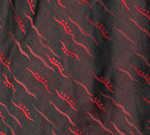The 1890s are defined by plain skirts, the rapid rise and fall of the sleeve, and the increased availability of silk. The American broad silk industry became firmly established during the 1880s. By the 1890s a profusion of colored, affordable (but not cheap), American manufactured silk yardage could be found in the new burgeoning city department stores, including Peck's in Lewiston, Libby's in Portland, and in small town dry-goods stores. Reasonably priced plain skirts, jackets, and blouses that became the norm for the working and active woman's everyday wear could be purchased ready-made. Immigrant labor was integral to this era of garment industry growth.
Labeled, "Harriman & Co. Portland Maine," Adela Adams' circa 1900 two piece has a velvet trimmed jacket styled with mild sleeve expansion, and the new plain, back pleated skirt. A very similarly styled a brown two-piece dress with the same pleated, full backed skirt, features a bodice with the very full 1894-1895 puffed upper sleeve, as does the collection's celadon green dress with a figured pink silk bodice and spreading collar trimmed with pink sequins.
Bedecked with wide satin ribbons, Myra Bradeen Philpot’s dainty cotton sprig-print 1894 summer wedding dress features large topped sleeves encased in semi-transparent tulle that creates a gigot-style effect. Her bridegroom Melville Philpot wore a black satin lapel tail coat, vest and elegant gray black striped trousers. Perhaps the most extreme mid-1890s sleeves are found among the collection’s wedding dresses, one of which is a long trained crisp woven stripe silk, worn by Jessie Christine Carter of Bath when she married Dr. Langdon T. Snips in 1896. Another is a statuesque gown of heavy cream satin, a similar fabric to the Haskell Silk Company wedding satin. Aside from wedding dresses, a bodice with a black satin vest-effect, labeled "Miss L. K. Stanley, 511½ Congress Street, Portland, Maine," features a mid-1890s balloon-sleeved blouse of red figured dress silk, the silk type now affordable and readily available.
By about 1898, the sleeve had deflated and lost its significance. The neat sleeves on an end-of-the-decade dark green wool suit are notable, not for size, but for small epaulettes, trimmed in black and red to match the standing collar, and bands embellishing the asymmetrical jacket front opening. Fitting close over the hips, the gored skirt flares at the hemline, heralding the style to come in the first years of the next century.
By this time, more women now worked outside the home. Positions such as store clerks, telephonists, office clerks, secretaries, and typists were opening up (by now typewriters were common in business use). Steadily increasing female participation in outdoor activities such as lawn tennis, ball games, and bicycling contributed to demand for, and development of, appropriate, comfortable work and sporting attire. By 1900 Sears catalogue offered smart sensible suits with silk lined jackets.

